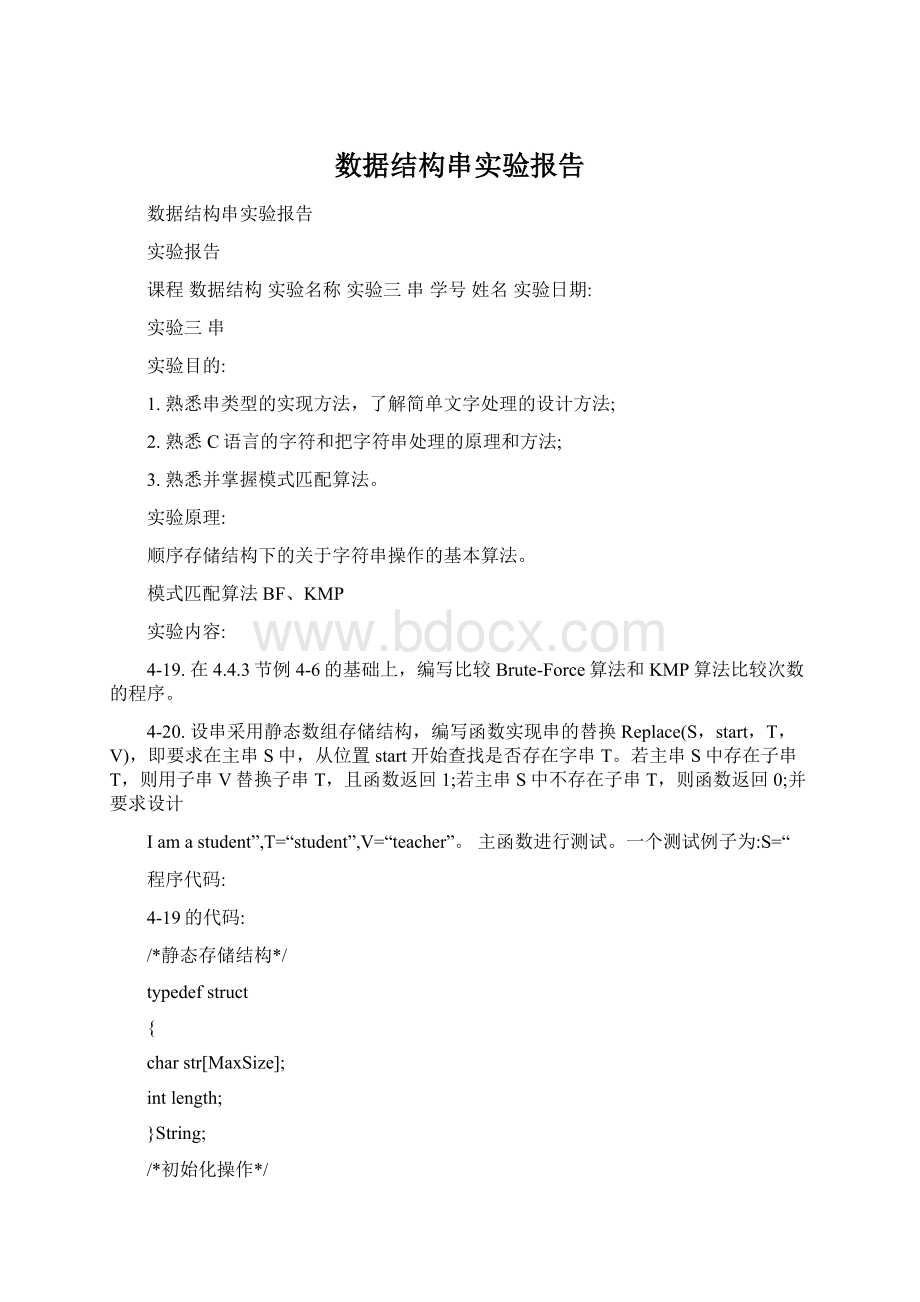数据结构串实验报告.docx
《数据结构串实验报告.docx》由会员分享,可在线阅读,更多相关《数据结构串实验报告.docx(10页珍藏版)》请在冰豆网上搜索。

数据结构串实验报告
数据结构串实验报告
实验报告
课程数据结构实验名称实验三串学号姓名实验日期:
实验三串
实验目的:
1.熟悉串类型的实现方法,了解简单文字处理的设计方法;
2.熟悉C语言的字符和把字符串处理的原理和方法;
3.熟悉并掌握模式匹配算法。
实验原理:
顺序存储结构下的关于字符串操作的基本算法。
模式匹配算法BF、KMP
实验内容:
4-19.在4.4.3节例4-6的基础上,编写比较Brute-Force算法和KMP算法比较次数的程序。
4-20.设串采用静态数组存储结构,编写函数实现串的替换Replace(S,start,T,V),即要求在主串S中,从位置start开始查找是否存在字串T。
若主串S中存在子串T,则用子串V替换子串T,且函数返回1;若主串S中不存在子串T,则函数返回0;并要求设计
Iamastudent”,T=“student”,V=“teacher”。
主函数进行测试。
一个测试例子为:
S=“
程序代码:
4-19的代码:
/*静态存储结构*/
typedefstruct
{
charstr[MaxSize];
intlength;
}String;
/*初始化操作*/
voidInitiate(String*S){
S->length=0;
}
/*插入子串操作*/
intInsert(String*S,intpos,StringT)
/*在串S的pos位置插入子串T*/
{
inti;
if(pos<0||pos>S->length)
{
printf("Theparameterposiserror!
\n");
return0;
}
elseif(S->length+T.length>MaxSize)
{
printf("Thespaceofthearrayisnotenough!
\n");
return0;
}
else
{
for(i=S->length-1;i>=pos;i--)
S->str[i+T.length]=S->str[i];
/*依次后移数据元素*/
for(i=0;iS->str[pos+i]=T.str[i];/*插入*/
S->length=S->length+T.length;
/*产生新的串长度值*/
return1;
}
}
/*删除子串操作*/
intDelete(String*S,intpos,intlen)/*删除串S的从pos位置开始长度为len的子串值*/
{
inti;
if(S->length<=0)
{
printf("Noelementsdeleting!
\n");
return0;
}
elseif(pos<0||len<0||pos+len>S->length)
{
printf("Theparametersposandlenarenotcorrect!
\n");
return0;
}
else
{
for(i=pos+len;i<=S->length-1;i++)
S->str[i-len]=S->str[i];
/*依次前移数据元素*/
S->length=S->length-len;
/*产生新的串长度值*/
return1;
}
}
/*取子串操作*/
intSubString(StringS,intpos,intlen,String*T)
/*取串S的从pos位置开始长度为len的子串值赋给子串T*/
{
inti;
if(pos<0||len<0||pos+len>S.length)
{
printf("Theparametersposandlenarenotcorrect!
\n");
return0;
}
else
{
for(i=0;i<=len;i++)
T->str[i]=S.str[pos+i];/*给子串T赋值*/
T->length=len;/*给子串T的长度域赋值*/
return1;
}
}
/*查找子串BF(Brute-Force)操作*/
intBFIndex(StringS,intstart,StringT)
/*查找主串S从start开始的子串T,找到返回T在S中的开始字符下标,否则返回-1*/{
inti=start,j=0,v;
while(i{
if(S.str[i]==T.str[j])
{
i++;
j++;
}
else
{
i=i-j+1;
j=0;
}
}
if(j==T.length)
v=i-T.length;
else
v=-1;
returnv;
}
/*查找子串KMP(D.E.Knuth-J.H.Morris-V.R.Pratt)操作*/intKMPIndex(StringS,intstart,StringT,intnext[])
/*查找主串S从start开始的子串T,找到返回T在S中的首字符下标,*/
/*否则返回-1*/
/*数组Next中存放有模式串T的next[j]值*/
{
inti=start,j=0,v;
while(i{
if(S.str[i]==T.str[j])
{
i++;
j++;
}
elseif(j==0)i++;
elsej=next[j];
}
if(j==T.length)
v=i-T.length;
else
v=-1;
returnv;
}
/*求模式串next[j]值的操作*/
voidGetNext(StringT,intnext[])
/*求子串T的next[j]值并存放于数组next中*/
{
intj=1,k=0;
next[0]=-1;
next[1]=0;
while(j{
if(T.str[j]=T.str[k])
{
next[j+1]=k+1;
j++;
k++;
}
elseif(k==0)
{
next[j+1]=0;
j++;
}
elsek=next[k];
}
}
/*查找子串BF(Brute-Force)算法累计次数*/
intBFIndexC(StringS,intstart,StringT)
/*查找主串S从start开始的子串T,找到返回T在S中的开始字符下标,否则返回-1*/
{
inti=start,j=0,t=0;
while(i{
if(S.str[i]==T.str[j])
{
i++;
j++;
}
else
{
i=i-j+1;
j=0;
}
t++;
}
returnt;
}
/*查找子串KMP(D.E.Knuth-J.H.Morris-V.R.Pratt)操作*/intKMPIndexC(StringS,intstart,StringT,intnext[])
/*查找主串S从start开始的子串T,找到返回T在S中的首字符下标,*//*否则返回-1*/
/*数组Next中存放有模式串T的next[j]值*/
{
inti=start,j=0,t=0;
while(i{
if(S.str[i]==T.str[j])
{
i++;
j++;
}
elseif(j==0)
i++;
elsej=next[j];
t++;
}
returnt;
}
测试主函数:
#include
#defineMaxSize100
#include"SString.h"
#include"BFandKMP.h"
voidmain(void)
{
StringS={{"cddcdc"},6},T={{"abcde"},5};
StringS1={{"aaaaaaaa"},8},T1={{"aaaab"},5};
StringS2={{"aaaaaaaaaaaaaaaaad"},18},T2={{"aaaab"},5};
intnext[20],count;
count=BFIndexC(S,0,T);
printf("从S中查找T的Brute-Force算法比较次数:
%d\n",count);
GetNext(T,next);
count=KMPIndexC(S,0,T,next);
printf("从S中查找T的KMP算法比较次数:
%d\n",count);
count=BFIndexC(S1,0,T1);
printf("从S1中查找T1的Brute-Force算法比较次数:
%d\n",count);
GetNext(T1,next);
count=KMPIndexC(S1,0,T1,next);
printf("从S1中查找T1的KMP算法比较次数:
%d\n",count);
count=BFIndexC(S2,0,T2);
printf("从S2中查找T2的Brute-Force算法比较次数:
%d\n",count);
GetNext(T2,next);
count=KMPIndexC(S2,0,T2,next);
printf("从S2中查找T2的KMP算法比较次数:
%d\n",count);
}
4-20的部分代码:
Replace函数:
/*从主串S中查找字串T,若存在,并用串V替换串T并返回1,否则,返回0*/intReplace(StringS,intstart,StringT,StringV)
{
inti,v;
Initiate(&S);
Initiate(&T);
Initiate(&V);
for(i=0;iS.length=S.length+1;
for(i=0;iT.length=T.length+1;
for(i=0;iV.length=V.length+1;
i=BFIndex(S,0,T);
if(i!
=-1)
{
if(Delete(&S,i,T.length))
Insert(&S,i,V);
for(i=0;iprintf("%c",S.str[i]);
printf("\n");
returnv=1;
}
else
{
printf("主串S中不存在串T\n");
returnv=0;
}
}
测试主函数:
#defineMaxSize80
#include
#include
#include"SString.h"
intmain(void)
{intv;
StringS={"Iamastudent."},T={"student"},V={"teacher"};
v=Replace(S,0,T,V);
printf("返回%d\n",v);
}
实验结果:
4-19.程序调式结果:
4-20.程序调式结果:
总结与思考
KMP算法的比较次数比Brute-Force算法的少。
KMP算法的主要特点是:
消除了Brute-Force算法的主串指针在相当多个字符比较相等后,只要有一个字符不相等便回退,也就是回溯的缺点。
所以从两种算法的原理和程序运行的结果来看,KMP算法比Brute-Force算法的效率更高。